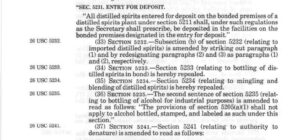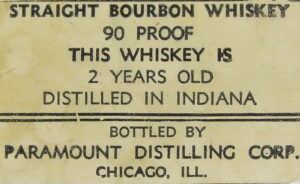
A couple of weeks ago I found myself in Bardstown with some unexpected time on my hands and decided to pay a visit to the Oscar Getz Whiskey Museum. It had been over a year since my last visit and at the time my interest in Prohibition-era artifacts was more about bottles and labels (of which the Getz has a lot) than historical documents. So a lot of things I’d kind of glossed over before now caught my attention. In particular was a display of federal publications from the period, most of which I was familiar with already. But there was one I’d never seen before called Regulations 11 Concerning the Prescribing of Medicinal Liquors. The publication date was May of 1933. Two things stood out right away.
First, I already knew of another publication, which I had thought pretty much covered this particular topic, entitled Regulations 60 Relative to the Manufacture, Sale, Barter, Transportation, Importation, Exportation, Delivery, Furnishing, Purchase, Possession, and Use of Intoxicating Liquor. This had been published back in 1920 right as national Prohibition started and proves the federal government was well prepared to switch to prescription-only sales of whiskey-as-medicine. I discussed this already in a previous article.)
Second, and more strikingly, was the publication date: May 1933. The 21st amendment had already been sent by congress to the states just two months earlier in February and it would be ratified before the end of the year. Additionally, the federal government had just made beer and wine legal again in April, the month before, when it passed The Cullen-Harrison Act [1]. So May seemed like a strange time to be publishing yet another set of requirements for prescribing medicinal spirits.
What exactly was Regulations 11 on about?
Finding copies of old federal publications can hard, especially if one doesn’t know the full title of what you’re looking for. In this case, the Getz display provided exactly what I needed: the title page. In one google search I had what I needed, and even a bit more.
As it turned out Regulations 11 was written to enact provisions of a bill that had been passed just two months earlier entitled The Medical Liquor Prescription Act. This very short bit of legislation (a copy of which was handily included in the PDF of Regulations 11 I had downloaded) called for, among other things, two very specific changes to the wording of The Volstead Act:
First, the act removed the explicit and original ‘one pint every ten days’ limitation in Title II, Sec 7 [2] and replaced it with language which allowed for more interpretation on the part of the physician, to wit:
“A physician shall not prescribe for a patient at any one time a quantity of spiritous or vinous liquor in excess of what he in good faith believes is required to meet the medicinal needs of the patient as shown by the patient’s condition at the time of prescribing.”
This quantity prescribed was also supposed to be enough for 30 days, though doctor’s were allowed to extend the supply to cover upwards of 90 days, if the patient’s condition warranted this. However this kind of ‘special’ prescription also required doctors to file more paperwork with the government.
Second, as part of Title II, Sec 8, it now called for the government to issue ‘stamps’ of some sort, in addition to official prescription blanks they were already providing. The stamps would need to be affixed by the doctor to every prescription they wrote. It did not say how many stamps would be issued at a time, presumably one per prescription blank [3].
The effect of the first provision seems obvious enough given the timing: with the 21st amendment on its way to being ratified, loosening some of the original restrictions on medicinal spirits likely seemed reasonable as this point. Moreover, some prescriptions written during the last year or so of Prohibition were already in excess of the 1 pint limit so limits obviously weren’t being tightly enforced.
Also keep in mind that just three years earlier, in 1929, the federal government had authorized the six distilleries holding medicinal spirits permits to produce an additional 3 million gallons of spirit. So dwindling pre-Prohibition stocks of whiskey had been somewhat replenished and were even approaching salable age. Not a bad time to make it easier to buy whiskey!
The second provision, the new stamps which needed to be attached to prescriptions, was probably an attempt to deal with counterfeiting. At the start of Prohibition blanks had been printed on plain colored paper w/ a pink duplicate for record keeping. These would have been easy to fake [4]. The design of the blanks was revised several times during Prohibition, with each revision a bit more elaborate and presumably harder to forge than the last. They became almost as detailed as paper currency. Clearly this wasn’t proving to be enough of a deterrent. Appropriately enough, the section on the stamps ends by describing a variety of consequences for anyone who ‘falsely makes, forges, alters, counterfeits or reuses any stamp made or used under the provision of this act.’ The penalties: a maximum fine of $1000 or imprisonment at hard labor for a maximum of two years.
And then, after all of this, with one final condition, the provision renders itself essentially moot:
“The effective date of this section shall not be earlier than January 1, 1934.”
In other words, with the end of national Prohibition in sight, there would be no more prescriptions by 1934, let alone some kind of new stamp or the pursuit of those who would counterfeit them.
This really was the last gasp of Prohibition.
—
Notes:
[1] So a curious thing about the enactment of national Prohibition is that the text of the 18th amendment specifically called out ‘intoxicating liquors,’ i.e. did not appear to include beer and wine. And a lot of people voted for it based on this understanding. However The Volstead Act, which gave the 18th the force of law, chose to include both of these in its definition. Hence, the federal government was within its rights to repeal the prohibition of beer and wine prior to the ratification of the 21st amendment since the 18th hadn’t explicitly forbidden them. Tricky, eh?
[2] Actually, in 1921, the limit had been reduced to just half a pint every ten days by The Willis-Campbell Act but it didn’t seem anyone ever enforced the revised (lowered) limit.
[3] The Willis-Campbell Act also limited the number of prescription blanks that could be issued to a doctor with a permit to 100 every 90 days. This was supposed to curb what some ‘drys’ felt was the blatant violation of Prohibition by doctors.
[4] There’s also evidence that some doctors would use the pink dupes instead of the original and these too were being accepted by some pharmacies.



